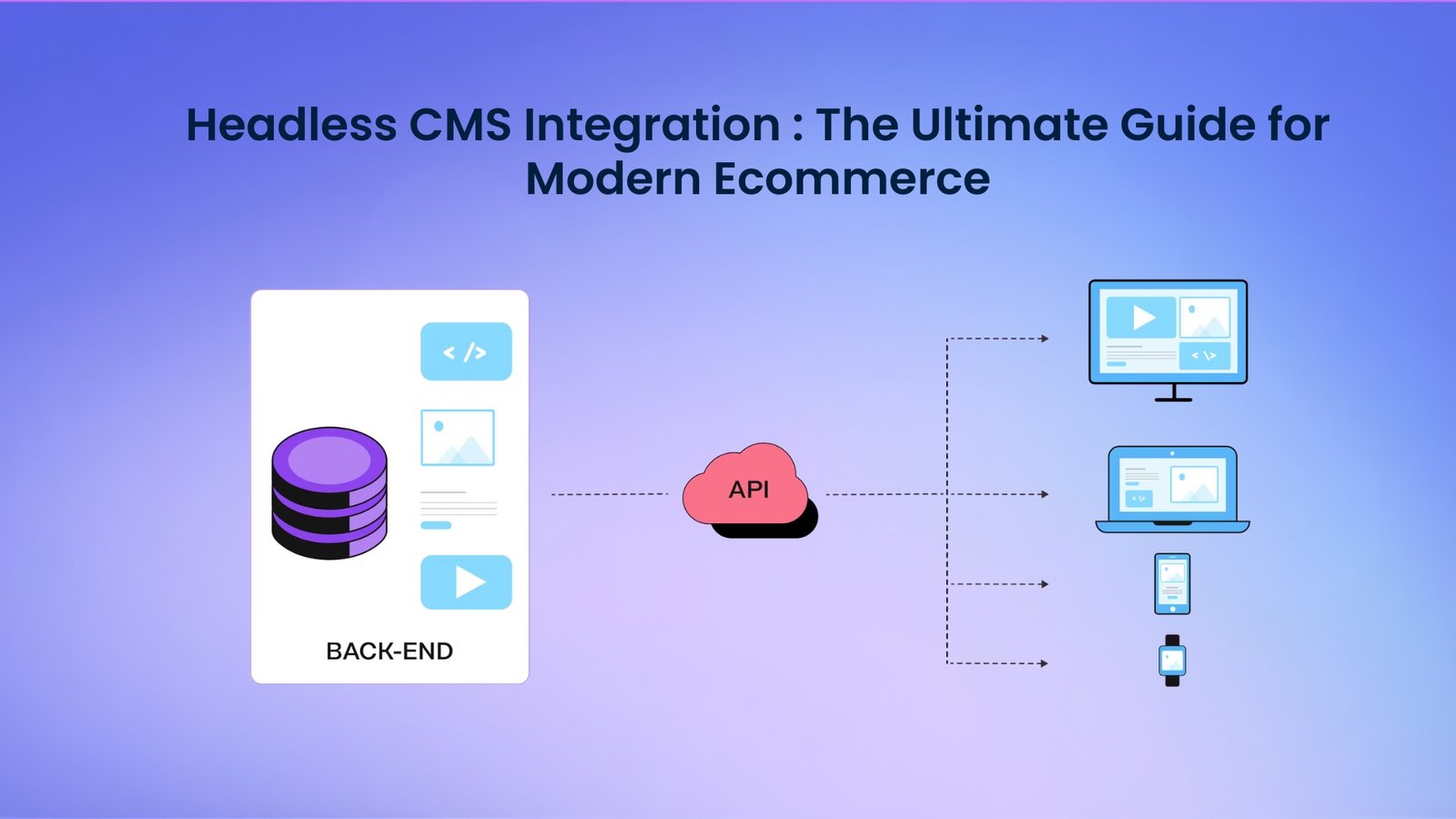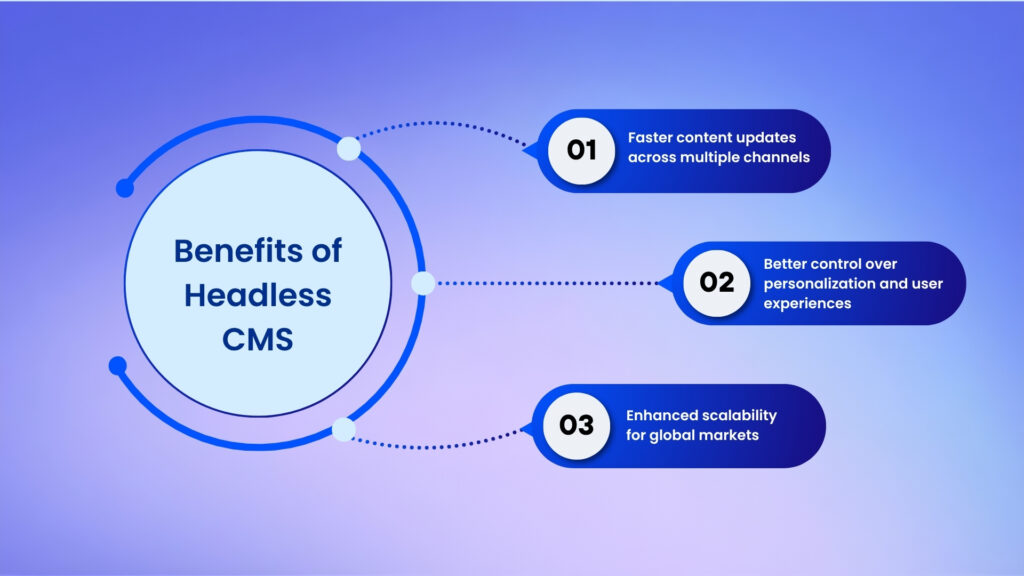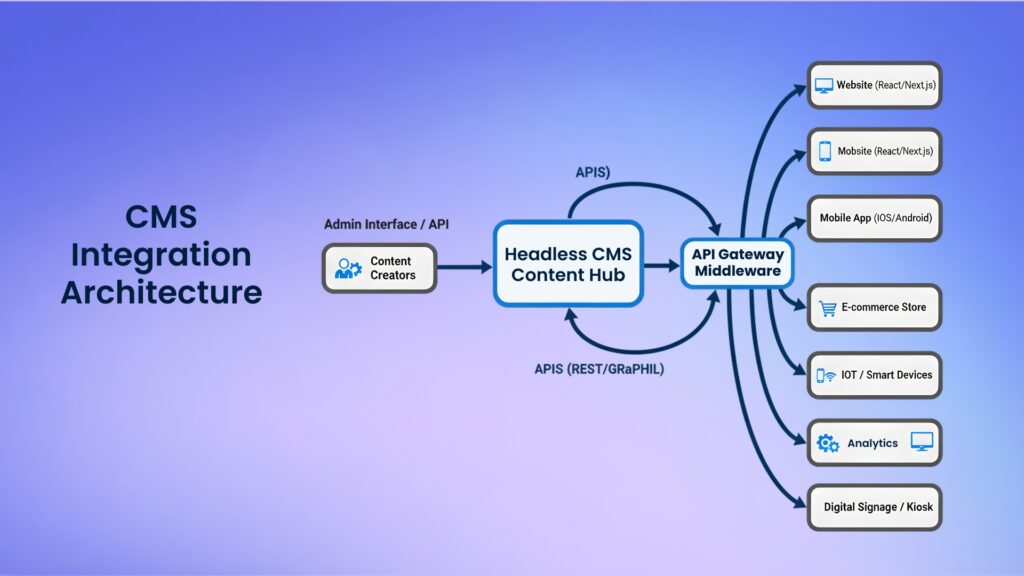AI-Driven Personalization in Ecommerce: How RBM Software Skyrockets Conversions!


Digital commerce has evolved far beyond simple online stores. Today’s customers expect seamless experiences across websites, mobile apps, social channels, and even voice or IoT devices. This expectation has exposed a major weakness in traditional CMS and ecommerce setups: they simply can’t keep up with the speed and flexibility that modern businesses need.
Traditional CMS platforms were built for a single channel, mostly web. They manage both content and design in one place, which made sense a decade ago. But as brands expanded to multiple touchpoints, this structure became restrictive. Updating content for every channel takes time, coordination, and repetitive work. For business leaders, that delay translates into slower campaigns, missed opportunities, and higher operational costs.
The real issue is that content and commerce often operate in silos. Marketing teams manage content in one system, while ecommerce teams handle product data and transactions in another. These disconnected workflows make it difficult to deliver consistent messaging and real-time updates across all customer touchpoints. It limits innovation and makes personalization almost impossible at scale.
This is where Headless CMS Integration with headless commerce changes everything. Instead of binding content and design together, a headless setup separates the backend (where data and logic live) from the frontend (what customers see). By integrating a flexible CMS with a headless commerce platform, businesses gain the ability to push content and product updates to any channel instantly.
The result is faster time-to-market, easier experimentation, and unified brand storytelling. Companies can personalize experiences dynamically, respond quickly to market trends, and scale operations without rebuilding their infrastructure every time a new platform or channel emerges.
Despite years of digital transformation, many organizations still struggle with a core issue: their CMS and ecommerce systems were never built to work together efficiently. These legacy setups limit creativity, slow operations, and make connected experiences difficult to deliver.
Traditional CMS platforms control both content and presentation within a single website framework. This worked when most interactions happened on desktop sites, but modern customers move between devices and channels—web, mobile apps, social media, smart TVs, and wearables.
For marketers and CXOs, this creates real challenges. Every new channel demands custom development and separate content formatting. The same content must be recreated multiple times to fit each platform, wasting time and resources. When speed matters, these limitations make omnichannel content delivery nearly impossible.
In traditional setups, ecommerce and CMS Integration platforms are tightly coupled. Every product update, pricing change, or campaign launch requires coordination between developers, designers, and marketers.
Consider launching a new product simultaneously across website, mobile app, and in-store displays. With a monolithic CMS, each update must be manually adjusted in separate systems, creating unnecessary delays. What should take hours stretches into days or weeks, costing momentum and market share.
Businesses struggle to stay agile while competitors using headless architectures push content and updates instantly.
Maintaining control and consistency across digital touchpoints becomes challenging without strong governance features. Traditional CMS Integration systems make it difficult to manage multiple authors, languages, and compliance standards.
For global organizations, marketing messages vary by region, translations fall out of sync, and compliance rules get missed. Without structured workflows and permissions, ensuring every piece of content aligns with brand guidelines and legal requirements becomes unreliable.
Inconsistent or outdated information across platforms signals poor coordination, damaging brand credibility and customer trust.
Data fragmentation represents the most critical issue. The CMS stores content separately while the ecommerce platform manages product catalogs, pricing, and orders. Without real-time communication between systems, businesses miss valuable insights.
Marketing teams lack access to current product data for campaigns. Ecommerce managers have no visibility into content performance or engagement. This separation makes personalization impossible, since data-driven decisions require connected ecosystems.
The result: unreliable analytics, limited automation, incomplete reporting, slower decisions, higher costs, and missed optimization opportunities.
Headless commerce has become one of the most transformative shifts in digital retail. It’s changing how brands manage content, products, and customer experiences across multiple channels. To understand its value, let’s break down what it really means and why integrating it with a CMS is such a game changer.
In simple terms, headless commerce separates the frontend of a digital store, what customers see and interact with from the backend, which handles data, inventory, and business logic. These two layers communicate through APIs, allowing them to work independently.
This separation gives brands total freedom over how and where they present content. Whether it’s a website, mobile app, smartwatch, or voice assistant, each channel can pull the same data from the backend through APIs. Updates can be made to one layer without disrupting the other, which speeds up development and content delivery.
For example, if a retailer wants to redesign their online store while keeping the same backend product system, they can do it quickly. The backend remains stable while the frontend evolves. This flexibility is what makes headless commerce ideal for businesses focused on omnichannel experiences and fast market adaptation.
The CMS plays a crucial role in this setup. Instead of being tied to a single website, a headless CMS acts as a centralized content hub. It stores, manages, and structures all the brand’s content, text, images, videos, metadata, and distributes it to any frontend through APIs.
This means marketers and content creators can manage everything in one place while developers focus on building dynamic customer experiences across channels. It also introduces stronger workflow management, version control, and permissions. Teams can maintain content governance with clarity, ensuring every asset follows brand and compliance rules.
In a headless architecture, the CMS doesn’t just create content. It orchestrates how that content is delivered, personalized, and updated across every digital surface.
When a CMS integrates seamlessly with a headless commerce system, the benefits are immediate and measurable.

Faster content updates across multiple channels:
Content and product data can be published in real time. Launching a new product line, campaign, or offer no longer requires multiple updates or platform-specific development. Everything flows through APIs, ensuring consistency and speed.
Better control over personalization and user experiences:
Since both the CMS and the commerce system share data through APIs, personalization becomes effortless. Businesses can tailor experiences based on user behavior, preferences, or purchase history without needing to re-engineer the entire system.
Enhanced scalability for global markets:
Headless architectures are inherently built for scale. As businesses expand into new markets, the CMS can easily manage localized content while the backend supports different currencies, languages, and product catalogs. This makes international growth smoother and faster.
In short, Headless CMS integration bridges creativity and commerce. It gives marketers the freedom to innovate while maintaining technical stability and scalability. For decision-makers, it’s a strategy that combines speed, control, and long-term efficiency, three things that define success in modern digital commerce.
CMS integration with a headless commerce platform requires careful planning, execution, and optimization. It’s not just about connecting systems, it’s about creating a unified digital ecosystem that enables speed, consistency, and intelligent automation. Here’s how businesses can approach the process step by step.
Every integration starts with clarity. Before implementing any technology, it’s important to understand what the business needs and what technical requirements will support it.
Start by identifying all digital channels where your brand interacts with customers websites, mobile apps, social platforms, in-store screens, or voice-enabled devices. Define what kind of content each channel requires and how it should interact with ecommerce endpoints like product catalogs, pricing systems, and checkout flows.
Once the scope is clear, define the key performance indicators (KPIs). These might include metrics such as time-to-market for new content, conversion rate improvements, content engagement, and customer retention. Clear KPIs will guide the architecture and help evaluate the success of the integration.
Choosing compatible platforms is a critical decision. The CMS and headless commerce engine must communicate effectively through APIs, ensuring smooth content delivery and data synchronization.
Popular headless CMS integration options include Contentful, Strapi, and Sanity, while leading headless commerce platforms include Shopify Plus, BigCommerce, and Commerce Layer. The best choice depends on your team’s technical capacity, the complexity of your catalog, and your scalability goals.
When comparing options, focus on:
Selecting the right combination early avoids costly adjustments later and ensures the integration remains future-ready.
This is the foundation of the entire process. The goal here is to establish a clear workflow between the CMS, ecommerce engine, and frontend layers.
At a high level, the CMS manages and structures content, the ecommerce platform handles transactional logic, and the frontend retrieves both through APIs to display them seamlessly. Each component must be designed to operate independently but communicate efficiently.

During this phase, it’s essential to define:
A well-designed architecture ensures that updates in one system instantly reflect across all touchpoints without disrupting others.
Once the structure is in place, governance becomes the backbone of consistency and quality. A strong content governance framework ensures that content creation, editing, and publishing follow structured workflows.
Define user roles and permissions to maintain control. For instance, content authors can create drafts, editors can review and approve, and administrators can publish. This layered process prevents errors and ensures every asset aligns with brand guidelines and compliance requirements.
Version control is equally important. Teams should be able to track revisions, roll back changes, and maintain historical accuracy. Through CMS Integration, governance becomes centralized ensuring that every content update, no matter how small, reflects consistently across all channels.
Testing is where everything comes together. Once the CMS and headless commerce platforms are connected, it’s time to validate how the integration performs across different channels and devices.
Test for content accuracy, design consistency, and loading performance across web, mobile, and other touchpoints. Ensure APIs respond quickly, product data syncs in real time, and personalization rules work as expected.
After launch, continuous optimization becomes a routine. Track engagement metrics, content performance, and conversion data to identify improvement areas. Real-time analytics will reveal which content drives the most interactions and where friction occurs in the customer journey.
This iterative process ensures the integration doesn’t just work technically but delivers measurable business value. Over time, testing and optimization help build a faster, smarter, and more customer-focused digital ecosystem.
Before Headless CMS integration
After Integration
They reduced the number of developer‐tickets per week significantly, increased publishing speed by 80 percent, and gained flexibility in design and content reuse. Contentstack
Before Headless / Omnichannel CMS Integration
After Integration & Key Metrics
Their results: within six months, they launched seven international storefronts in three languages and four currencies. They saw site traffic more than double (104% increase), revenue grow by 146%, and conversion rates increase by 50%.
CMS Integration with headless commerce is not just a technical upgrade, it’s a strategic investment. Decision-makers need to see measurable returns to justify the effort, and the impact shows up across speed, revenue, and customer engagement.
Time-to-Market Reduction:
One of the most immediate benefits of Headless CMS integration is faster deployment. Content updates, product launches, and marketing campaigns can go live across all channels simultaneously. Brands often see a reduction in time-to-market by 40 to 60 percent. Faster launches mean quicker revenue generation and the ability to respond dynamically to market trends.
Conversion Rate Improvement:
With better control over content delivery and personalization, conversion rates improve significantly. When content and product data are integrated seamlessly, customers experience consistent messaging and relevant recommendations, which drives higher purchases. Brands adopting headless CMS integrations typically report 20 to 50 percent increases in conversion rates within the first six months.
Customer Engagement Scores:
Headless CMS integration enables personalized experiences across multiple channels. By tracking engagement metrics such as session duration, repeat visits, and click-through rates, businesses can evaluate how well their content resonates with customers. Improved engagement reflects stronger brand loyalty and higher lifetime customer value.
Beyond metrics, the CMS integration influences strategic decision-making. When content, product, and customer data are unified:
In essence, Headless CMS integration transforms fragmented data into actionable intelligence. Leaders can make informed, data-driven decisions that improve efficiency, customer satisfaction, and overall business performance.
CMS Integration with a headless commerce platform can deliver huge benefits, but only if it is implemented thoughtfully. Adopting best practices ensures the system remains efficient, scalable, and secure while driving measurable business value.
Strong content governance is essential for consistency and quality across all channels. Define clear workflows and approval processes so that every piece of content passes through the appropriate checks before publishing. Assign roles and permissions for content creators, editors, and administrators to prevent errors or unauthorized updates. A structured governance framework ensures brand consistency, compliance with internal policies, and alignment across marketing, ecommerce, and operations teams.
Headless CMS integration should not only solve today’s challenges but also accommodate future growth. Ensure that both the CMS and headless commerce platform can handle increasing traffic, additional product lines, and new digital channels without performance degradation. Scalable architecture allows brands to expand globally, add languages and currencies, and launch new storefronts without major redevelopment or downtime.
Security and compliance cannot be overlooked. Integrated systems handle sensitive customer information, transactional data, and proprietary content. Implement robust security measures such as API authentication, data encryption, and access control. Additionally, ensure the platform supports global compliance requirements like GDPR, CCPA, or PCI DSS. Protecting customer data builds trust and reduces legal and financial risks.
Integration is not a one-time task; it requires ongoing monitoring and optimization. Track KPIs such as time-to-market, conversion rates, and engagement metrics regularly. Analyze the data to identify bottlenecks, underperforming content, or opportunities for personalization. Iteratively improving both the system and workflows ensures that the headless CMS integration continues to deliver value as business needs and customer expectations evolve.
By following these best practices, organizations can maximize the return on their CMS Ecommerce Integration investment, maintain operational efficiency, and deliver a superior customer experience across all channels.
While Headless CMS integration offers significant advantages, businesses often encounter challenges during implementation. Understanding these obstacles and addressing them proactively ensures a smoother transition and maximizes ROI.
CMS Integration with a headless commerce platform requires strong technical skills. APIs, data mapping, and front-end/backend separation can be complex for teams without prior experience. To overcome this, businesses should engage experienced developers or partner with technology vendors specializing in headless architectures. Clear documentation, training, and phased implementation can also reduce the risk of errors and delays.
One of the most common hurdles is ensuring real-time data flow between content and commerce systems. Inconsistent or delayed updates can affect product information, pricing, and content accuracy, undermining customer trust. Using middleware or integration platforms can help synchronize data efficiently. Regular monitoring and automated alerts ensure that discrepancies are detected and resolved quickly.
A shift to headless architecture often requires teams to adjust how they create, manage, and publish content. Resistance or lack of familiarity can slow adoption. Overcoming this challenge requires structured change management: provide hands-on training, define clear roles, communicate benefits, and establish new workflows gradually. Leadership support and continuous feedback loops help teams adapt faster and embrace the new system fully.
By anticipating these challenges and planning solutions in advance, businesses can successfully implement Headless CMS integration while minimizing disruptions and maximizing the strategic benefits of a modern, flexible ecommerce ecosystem.
CMS Integration with headless commerce has become essential for businesses competing in digital-first markets. The combination of flexible content management and decoupled ecommerce architecture enables organizations to deliver seamless, consistent experiences across all customer touchpoints.
The benefits are measurable. Brands achieve faster time-to-market, launching campaigns and products without unnecessary delays. Improved content governance ensures consistency, quality, and compliance across channels. Enhanced user experiences powered by personalization and real-time updates drive engagement, conversions, and customer loyalty.
RBMSoft brings proven expertise in Headless CMS integration. We’ve helped organizations across retail, manufacturing, and B2B commerce implement scalable architectures that deliver results. Our approach combines technical precision with business strategy—we don’t just connect systems, we transform how content and commerce work together.
What sets RBMSoft apart:
We’ve guided companies through complex migrations from monolithic systems to modern headless architectures, reducing time-to-market by 40-60% and improving conversion rates by 20-50% within the first six months.
If your business needs to unlock speed, flexibility, and operational efficiency through CMS Ecommerce Integration, Contact RBMSoft to discuss how we can help you achieve similar results.
CMS Integration connects your content management system with your ecommerce platform, allowing content and product data to work together seamlessly. It ensures consistent messaging, faster updates, and better customer experiences across multiple digital channels.
Headless commerce decouples the frontend from the backend, enabling content to be delivered via APIs to any channel. This allows marketers to update content independently, manage personalization, and maintain a consistent experience across websites, mobile apps, social media, and more.
Successful integration involves:
– Assessing business and technical requirements
– Selecting compatible CMS and headless commerce platforms
– Designing the integration architecture
– Implementing content governance rules
– Testing and continuously optimizing for performance and engagement
Yes. Many legacy CMS platforms can be adapted for headless integration using APIs or middleware. However, the complexity depends on the CMS’s flexibility and the technical expertise available. In some cases, moving to a fully headless CMS may be more efficient.
Businesses track metrics such as time-to-market reduction, conversion rate improvements, customer engagement, and content accuracy. The integration also enables data-driven decisions that improve marketing, sales, and operational efficiency, contributing to measurable ROI.
Content governance ensures that all digital assets are reviewed, approved, and consistent across channels. It prevents errors, maintains brand integrity, and ensures that customers receive accurate, timely, and engaging content, which strengthens trust and loyalty.